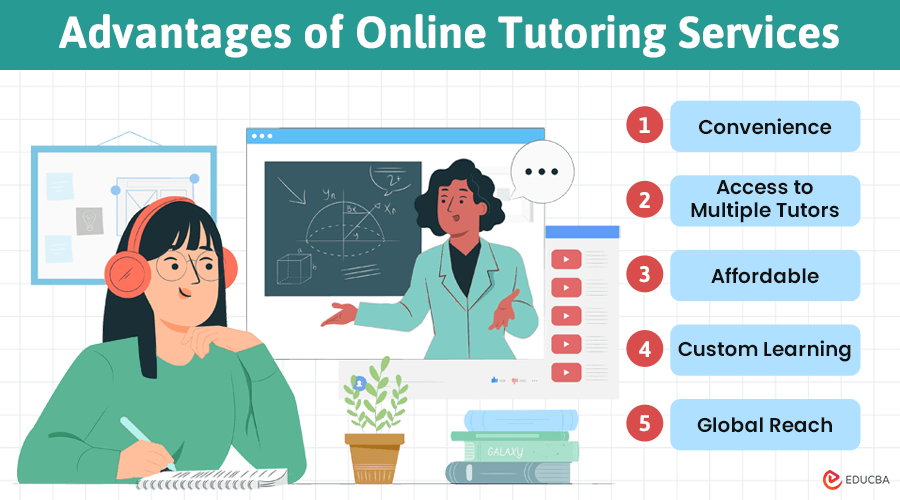
What is Online Tutoring?
Online tutoring is a service that allows students to learn remotely by connecting them with tutors using video calls, chat features, and other digital tools. This makes learning more flexible and accessible.
Various online tutoring websites provide such services, and versatile courses are available that students can learn from the comfort of their homes.
In this article, we will learn:
- How online tutoring works?
- How to set up sessions?
- How to find the right tutor?
- Benefits and challenges
How Online Tutoring Works? (Step-by-Step Guide)
The process of online tutoring includes the following steps:
Step 1: Signing Up on the Platform
Organizing an online mentoring class is not a hassle. To begin with, students must sign up on a tutoring application or website, create a profile with their educational objectives, and specify the subjects they wish to learn. With Art of Smart tutoring, students receive personalized guidance tailored to their learning needs, ensuring a more effective and structured approach to academic success.
Step 2: Searching for a Tutor
Once your account is set up, the next step is to search for a tutor. Finding the right tutor is critical for a productive learning experience.
- Specify the Subject: Start by choosing the subject you need help with. Most platforms allow you to search by subject, grade level, or topic.
- Filter Tutors: Use filters to narrow down tutors by their experience, teaching style, and ratings from other students. Many platforms also provide tutor profiles that include photos, qualifications, and reviews from previous students.
- Compare Tutors: Compare different tutors based on their profiles and feedback from other learners. Look at their qualifications, availability, and hourly rates to ensure they fit your needs.
Step 3: Booking and Scheduling a Session
After choosing a tutor, you can book and schedule your session.
- Choose a Time: Platforms typically have a built-in calendar feature that allows you to select a time that works best for you. Check the tutor’s availability and choose a suitable time slot.
- Confirm Booking: Once you pick a time, confirm the session. Look for the confirmation email or notification.
- Modify or Cancel: If your schedule changes, most platforms offer the option to modify or cancel your session. Make sure to check the platform’s cancellation policy to avoid any fees.
Step 4: Conducting the Tutoring Session
Students and tutors connect through video calls and chat features. They use digital tools like virtual whiteboards to enhance learning.
During the session, tutors explain concepts and answer questions. Students can share their screens to show their work. This interactive approach helps students grasp difficult topics more easily.
Step 5: Post-Session Review and Activities
After the tutoring session, students can review what they learned. Many platforms allow session recordings for later access, which helps students revisit important topics and reinforces their understanding.
Tutors often provide homework or additional resources. Students can use these materials to practice and improve their skills. Progress tracking features help students see their improvement over time.
Payment and Pricing Models
Payment and pricing models for such tutoring vary by platform. Most tutors charge hourly rates for their sessions. Some platforms offer subscription packages for ongoing support.
Students can select a pricing model within their economic range. Some platforms offer discounts for long-term contracts, making online tutoring services affordable for many learners.
Advantages of Online Tutoring Services
Online tutoring has several benefits:
1. Convenience: Learners can arrange sessions whenever it is suitable for them, enabling them to work the learning around their very busy schedules.
2. Access to Multiple Tutors: Choose from a wide range of experts in different subjects.
3. Affordable: The rates charged for professional assistance over the Internet are way cheaper than those for face-to-face mentoring, which makes it less expensive.
4. Custom Learning: Each student profile is different, so different students are taught differently to better understand.
5. Global Reach: You can connect with tutors worldwide, regardless of location.
Challenges and Solutions
Online tutoring comes with its own challenges, such as:
- Technical Issues: Poor internet connection can interrupt sessions.
- Adapting to Virtual Learning: Some students may find it hard to adjust to online learning.
Solutions:
- Support: Many platforms offer troubleshooting guides for common technical issues.
- Engaging Methods: Tutors can use various teaching tools to make sessions interactive and engaging.
Frequently Asked Questions (FAQ’S)
Q1. How do I find a tutor?
Answer: Students can search for tutors using online platforms. They can filter results based on subjects, ratings, and availability.
Q2. What tools do tutors use during tutoring sessions?
Answer: Tutors use video calls, chat features, and digital whiteboards. These tools help facilitate interactive and engaging learning experiences.
Q3. Can I schedule sessions at any time?
Answer: Yes, most platforms allow students to schedule sessions at their convenience. This flexibility helps fit tutoring into busy schedules.
Q4. How is payment handled for tutoring services?
Answer: You can make payments through the tutoring platform. You can choose hourly rates or subscription models based on your needs.
Final Thoughts
Individualized tutoring is a great assistance to students who require a constant helping hand. Students can efficiently use tutoring platforms to improve their academic performance and get the personalized support they need to succeed.
Recommended Articles
If you found this article on ‘Online Tutoring‘ interesting, you can also check the suggestions below:
